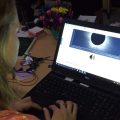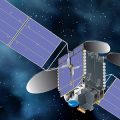Explore the universe with “Smithsonian’s Stars”
The Smithsonian’s National Air and Space Museum, in partnership with the Smithsonian Astrophysical Observatory and the National Museum of Natural History, is hosting a new annual series of lectures by Smithsonian researchers who are exploring the sun, the moon, planets, stars, galaxies and the universe. The “Smithsonian’s Stars” free public lectures will take place Saturday evenings, October through February 2012, and will present research projects conducted by scientists, historians and educators at the Institution.
Each free program will include a live planetarium program delivered in part by Smithsonian experts in the museum’s Albert Einstein Planetarium. Accompanying the planetarium program will be relevant hands-on educational activities and—weather permitting—sky observing in the museum’s public observatory. The Smithsonian’s Stars Lecture Series is made possible by a grant from NASA.
Scheduled Programs
Oct. 22: “How to Learn a Star’s True Age”
Soren Meibom, Smithsonian Astrophysical Observatory
Nov. 5: “Close-up Views of an Active Mars”
Patrick Russell, National Air and Space Museum’s Center for Earth and Planetary Studies
Nov. 19: “Selecting the Landing Site for the Mars Science Laboratory”
John Grant, National Air and Space Museum’s Center for Earth and Planetary Studies
Dec. 3: “Love, Fear and Greed: Why We Should Go to the Asteroids” Martin Elvis, Smithsonian Astrophysical Observatory
Dec. 17: “Antarctic Meteorites: Collection, Classification, Curation and Investigation”
Cari Corrigan, National Museum of Natural History
Jan. 14: “Crashing Galaxies: New Insights into Our Future”
Lauranne Lanz, Smithsonian Astrophysical Observatory
Jan. 28: “Sand Dunes throughout the Solar System”
Jim Zimbelman, National Air and Space Museum’s Center for Earth and Planetary Studies
Feb. 11: “Highlights from NASA’s Chandra X-ray Observatory”
Harvey Tananbaum, Smithsonian Astrophysical Observatory
Feb. 25: “Revealing Mercury’s Secrets with the MESSENGER Spacecraft”
Maria Banks, National Air and Space Museum’s Center for Earth and Planetary Studies
For more information on each lecture and to request free tickets, visit the website.

"Erupting into Space." An 86-mile-high volcanic plume explodes above the horizon of Jupiter’s moon Io. The plume is erupting over a caldera (volcanic depression), named Pillan Patera, after a South American god of thunder, fire, and volcanoes. Galileo, June 28, 1997. (Credit: NASA; JPL; PIRL; University of Arizona; Kinetikon Pictures. Copyright Michael Benson)
Posted: 18 October 2011








